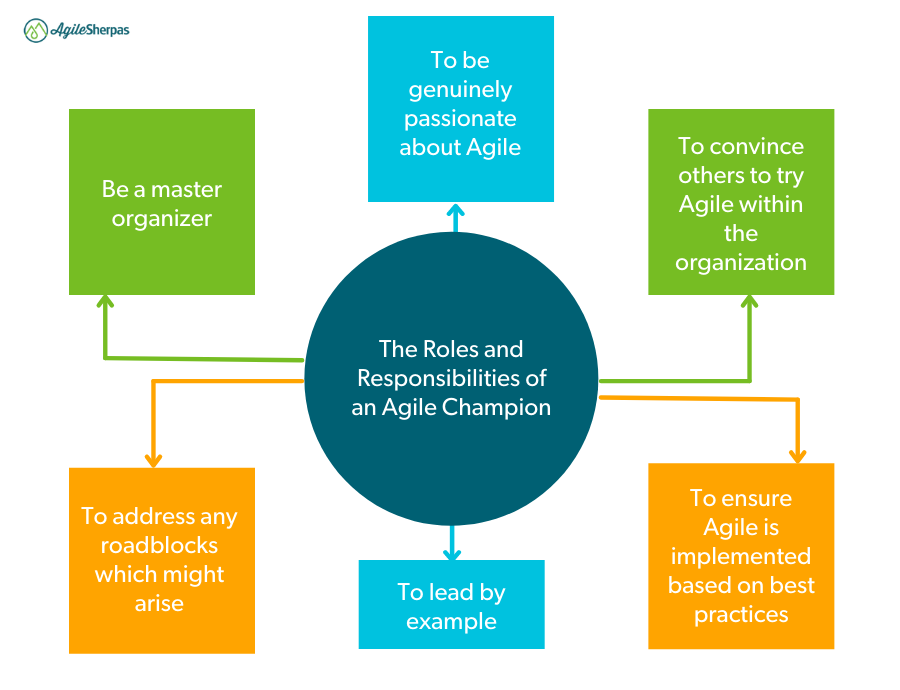Teams, organizations, and functions of all kinds are flocking to Agile frameworks, looking to better manage market uncertainty, shifting priorities, and evolving customer expectations.
But not every Agile transformation succeeds.
Without a strong, well-supported Agile champion, efforts at Agile adoption may fizzle.
If Agile is a "side of the desk" project without someone dedicated to it, there's a much greater chance of failure. Of course, being a champion doesn't mean carrying the whole transformation on your back.
The Agile champion doesn't have to do every training or coach every team. Their responsibilities are more centered on oversight, socialization, and impediment removal.
Successful Agile champions have a team (either external consultants/coaches or internal centers of excellence) supporting them, but they're the ones responsible for making Agile a reality in their organization. To find the strongest Agile champion for your transformation, look for someone with these six characteristics.
What is an Agile Champion?
Before we dive into traits, let's first make sure we know what an Agile champion really is.
During an Agile implementation, questions like these will inevitably arise:
- This part of Agile doesn’t seem to work for us, should we modify or abandon it?
- Some of our colleagues aren’t exactly enthusiastic about this change, how can we get them on board?
- Higher ups want updates on our progress, who’s going to speak to them and answer their questions?
An Agile Champion is, in part, the person who can answer these (and many other) questions along the path to true agility. They should be enthusiastic and knowledgeable about Agile, enabling them to lead, inspire, and troubleshoot an Agile implementation. They act as the face of the implementation within the organization and are always there to support.
However, it’s also important to understand that different organizations take their own approaches to Agile champions.
The biggest variation is generally whether or not an Agile champion should advocate upward within the organization. Sometimes this is a key part of their role, while in other cases they solely focus on facilitation and implementation. So consider which version is most appropriate for your organization before electing a champion.
A final element worth thinking about is the difference between an Agile champion’s day-to-day role and their longer-term responsibilities.
Everything mentioned below should be considered in the context of those longer-term goals.
No surprise then that it’s a role with some heavy responsibility. So if you or a team member is taking on the challenge, what should they be prepared to do if they want to succeed?

The Roles and Responsibilities of an Agile Champion
We’ve broken down the basics of being an Agile champion into six key responsibilities that you need to be aware of.
What you’ll actually be doing will vary, but as long as you’re upholding these six pillars, you should be well on your way to leading a successful Agile implementation.

1. To be genuinely passionate about Agile
This should be a bit of a given, but it's absolutely essential. An Agile champion shouldn’t just be deeply familiar with Agile, but also deeply passionate about the values as well.
They need to be able to inspire others to get invested in the Agile transformation and problem-solve along the way.
That passion and enthusiasm should be infectious and help convince other team members to get on board with the Agile transition because they want to, not just because it has been mandated.
An Agile champion shouldn’t be someone who simply “got volunteered,” but someone who actually wanted the role. After all, it’s not easy to be genuinely passionate about something you’re being forced to do.
But that passion is also critical for being a better Agile advocate.
After all, Agile is more than a process framework, it’s a mindset.
2. To lead by example
Because Agile is about more than just “going through the motions,” an Agile champion should be able to lead by example. This means leading in both actions and mentality.
An Agile champion has to define what the change that needs to happen is as well as make it clear what steps will get everyone there.
This is particularly important because no two Agile implementations will be completely identical. Part of the role of an Agile champion is to determine how best to implement Agile in their specific circumstances.
So leading by example also means showing how your team is going to do Agile in their own way.
By showing what Agile looks like and is capable of instead of simply telling team members about it, a champion is far more likely to persuade and inspire. So, Agile champions have to consider how they can best utilize their passion for and knowledge about Agile to lead by example.
Before exploring the next responsibility, why don't you take a second to get our Agile Marketing Transformation Checklist?
3. To convince others to try Agile within the organization
While much of what an Agile champion does will be leading an Agile transition, the role often involves being an evangelist for Agile within the broader organization as well.
As mentioned, an Agile champion should be ready to answer questions and this includes from other teams who might be interested in trying Agile for themselves.
Just be mindful that there’s a danger of biting off more than you can chew.
Trying to run too many simultaneous Agile transitions within an organization can spread resources too thin and decrease the chances of success. The best approach is usually to start by getting Agile working well in a single team or department before expanding.
And, of course, bringing in the right subject matter experts can help extend the impact of an internal champion. Specialized training, like those offered here at AgileSherpas, help ensure a transformation's success and allow an Agile champion to reach farther into an organization.
4. To ensure Agile is implemented based on best practices
Just because Agile methods can be adapted for specific circumstances doesn’t mean “anything goes.” An Agile champion must be able to draw the line to ensure that Agile adaptations don’t slip into “fake Agile” territory or begin to backslide.
This means being heavily involved in Agile processes, at least initially, to monitor how things are going.
However, this doesn’t mean the champion’s only role is to police the Agile implementation, saying “no, that’s not real Agile.” They should also use this involvement to proactively suggest modifications, tips, etc.
5. To address any roadblocks that come up
Inevitably, an Agile implementation is going to encounter challenges along the way. These challenges can easily derail the process entirely and lead to rumors that “Agile doesn’t work for us”.
Without someone to turn to, team members risk getting stuck or frustrated. An Agile champion needs to be easily accessible to answer these questions and help train team members on how to use Agile to troubleshoot and solve problems on their own in the future.
However, this part of the role also covers instances where an organization might reach a plateau in their Agile implementation.
This different sort of “roadblock” is also something an Agile champion should be able to identify and address with proposed next steps.
6. Be a master organizer
Any Agile implementation ultimately comes down to a series of decisions. The problem comes when no one is held accountable for creating opportunities for communication that will result in those decisions being made.
When those decisions don’t get made and no one is accountable, the entire transformation process can derail.
That’s why an Agile champion needs to act as a coordinator during a transformation. They shouldn’t be making all the decisions, but they do need to work to ensure they get made.
Agile Champions Need Resources
Being an Agile champion means taking on quite a lot of responsibility. That’s why anyone taking on the role needs the right support.
That can come in the form of books like The Agile Leader or, even better, from hands-on trainings designed to teach high-impact skills like Agile Marketing Leadership.
If you're short on time and need a quick way to boost your Agile knowledge, check out the library of microlearning content we developed based on years of working with Agile marketing teams, and the following 4 microlearning paths in particular:
Each of them contains 10 bite-sized lessons, 20 short engaging videos, and 10+ downloadable resources that can boost your Agile knowledge in minutes even during the busiest days.
In any case, Agile champions always need support and resources to ensure their critical role, and by extension the entire Agile transformation, is a success.
Before you move on, why don't you take a second to get our Agile Marketing Transformation Checklist?